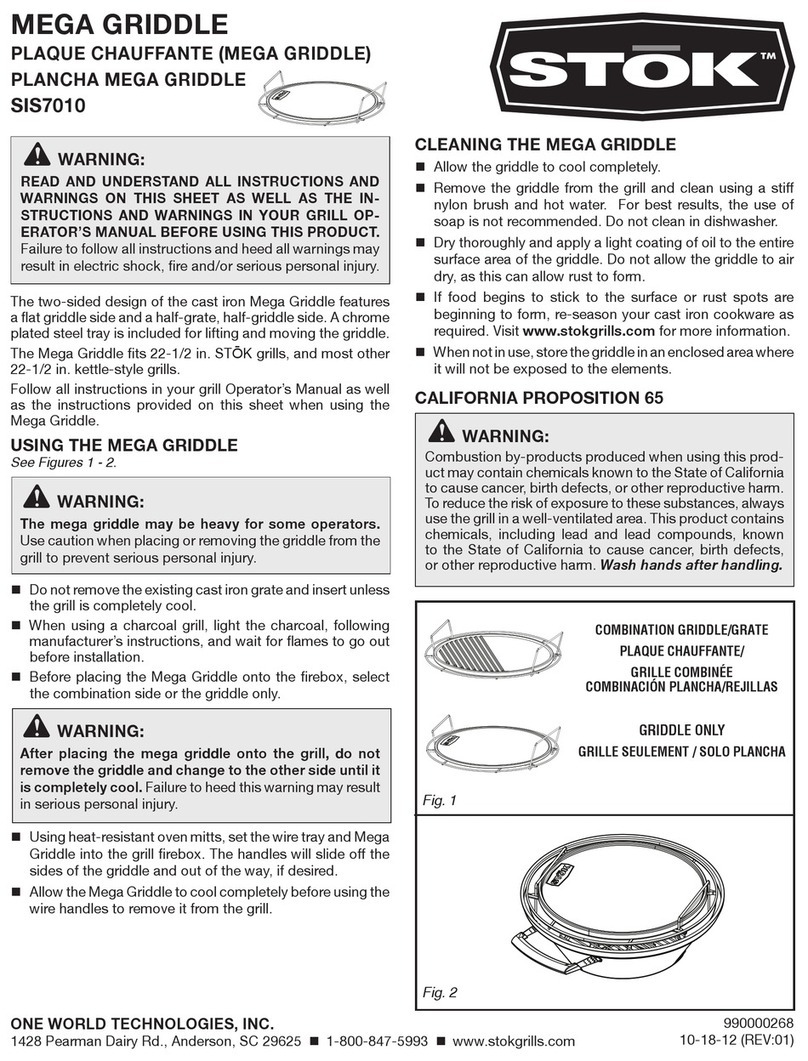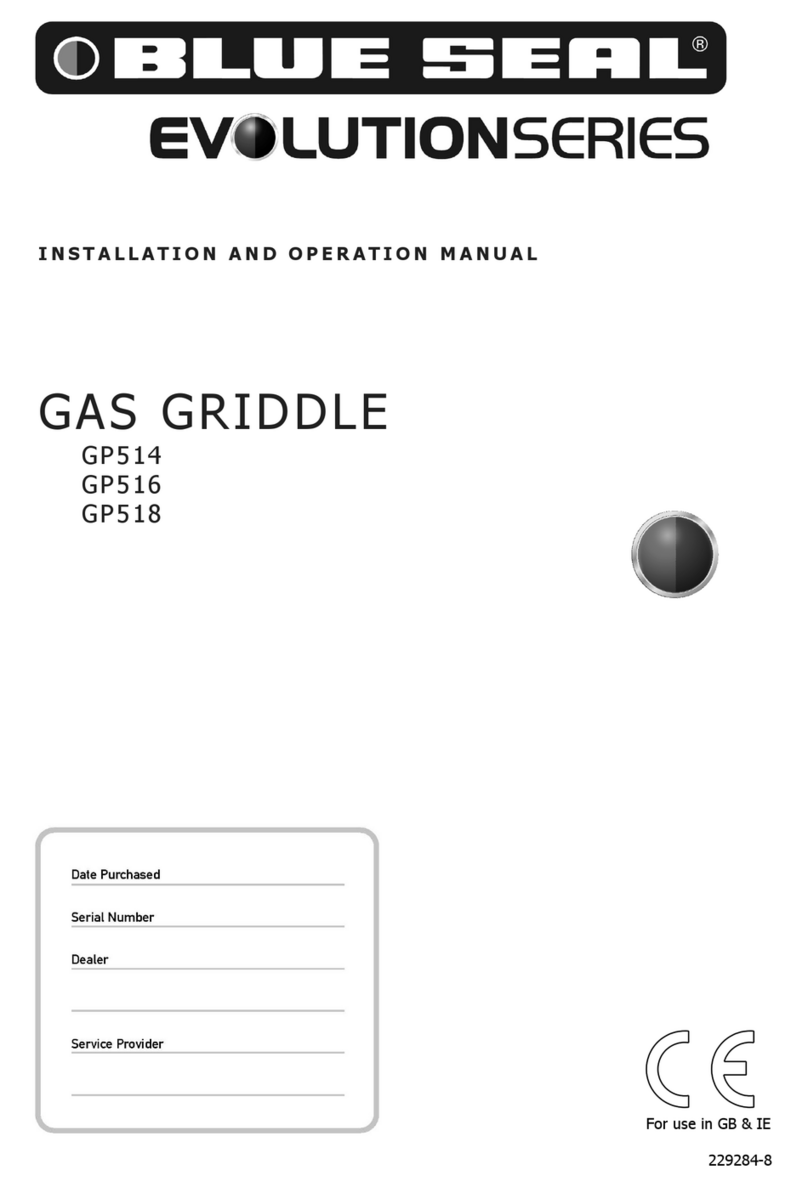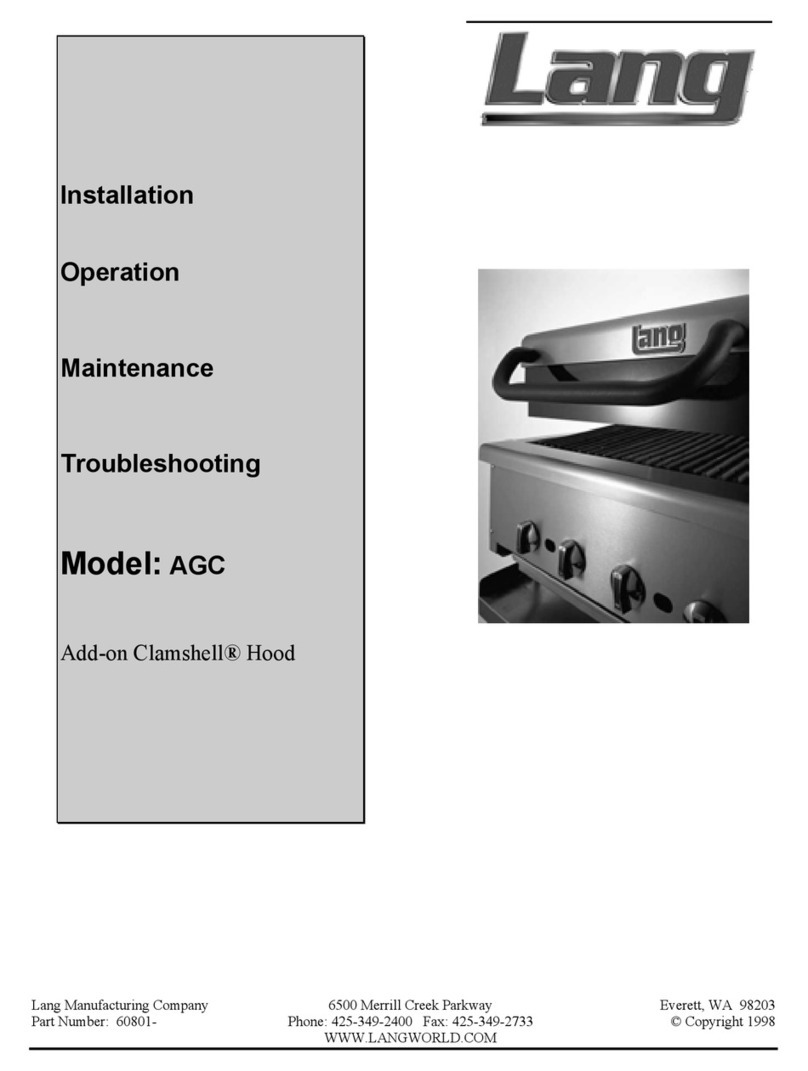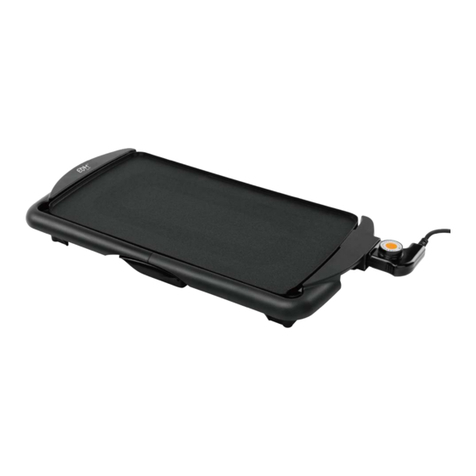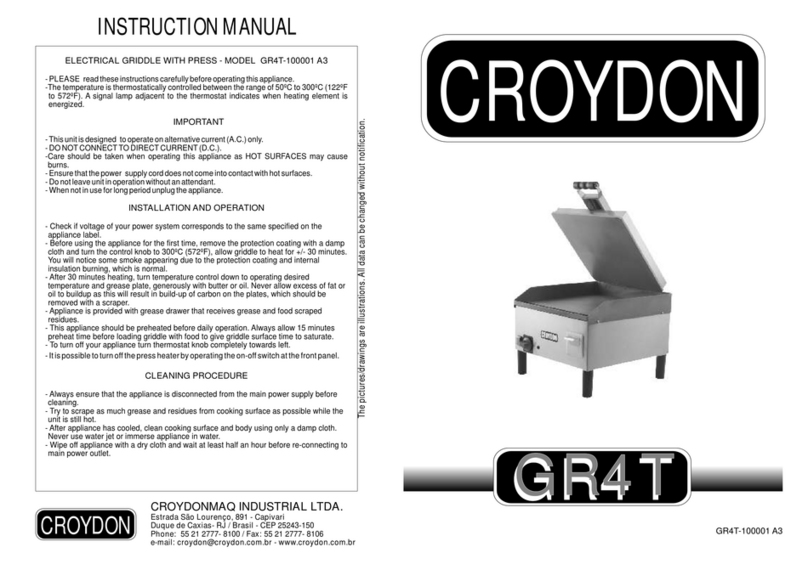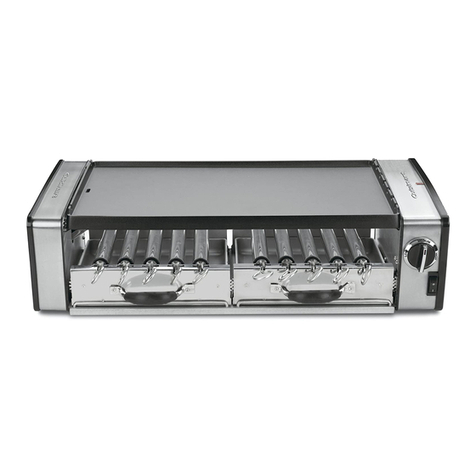EmberGlo E2412 Use and care manual

Char Broiling the Electric Way!
When FLAVOR is your #1 priority an
EmberGlo char-broiler is your #1 choice.
Electric Char-Broiling is Fast
Prepare a perfectly branded hamburger in 4 minutes or
charbroil an 8 ounce refrigerated strip sirloin in as little as
7 minutes! Compare this to any competitive 36" model,
and you’ll see why EmberGlo® offers more produc-
tion capacity in the same amount of floor space. Any
foodservice operation, no matter what size, can install a
dependable and profitable charbroiling system in an area
as small as 12" wide. Yet the same basic system can be
expanded to fit a space of two, three or more feet wide
for larger restaurants and chain operations. Whether you
want to increase your broiling in a big way or just add a
little variety to your menu, there is a place in your opera-
tion for the, heavy duty, E24 Series Electric Broiler from
EmberGlo®.
Accessories for Electric Char-Broilers
Increase your efficiency with accessories made just for
your broiler. Our stainless steel Grill Brush and Splatter
Guard is great for an easy clean up.
4140 West Victoria Street - Chicago, Illinois 60646
toll: 866 705 0515 - tel: 773.604.8700 - fax: 866.580.8700
1210
8474 75E Quality Designed for Proven Performance
Printed in USA
1210
8474 75E
Great Chef ’s Secrets
to Char Broiling. . .
Electric
Char Broiler
Cooking Guide
www.emberglo.com
Broiler Features
Stainless steel construction
More Useful Broiling Surface than Competition
Counter Models (Optional Floor models available)
Lift out Cook Top Grate for reduced cleanup
Minimum Heat Radation
Recesses Heating Elements / Flame Free Broiling
Removable Grease Tray & Slpatter Guard
Infinitely Adjustable Temperature Zoned Cooking
Helpful Hints for the best performance on your
Electric EmberGlo Char-Broiler:
1) The temperature at the grill surface, as in all cook-
ing processes, is most important to the quality of food it
produces. All units will reach proper broiling temperature
with a switch setting of 5 to 5 1/2. This setting will yield
between 500° and 550°. The unit will reach broiling tem-
perature in approximately 6 to 10 minutes. Any attempt
to broil for long periods of time with the controls above 6
may cause meat to burn. Higher temperatures allow for
rapid cooking times and marked surfaces that some cus-
tomers prefer, while low temperatures are for thick cuts
of meat that must cook longer without surface excessive
charring. Extreme grill temperatures should be avoided.
2) Keeping your grates clean after every cook is impor-
tant. Old food isn’t seasoning - it’s crud. A clean grate is
less likely to be sticky and will last longer.
3) At the end of the day turn unit to “HI” and leave on for
approximately 45 minutes. This will char the remaining
grease on the grill casting. Turn off controls. When grill
is cool, scrape the underside again and wire brush the
surface to complete cleaning of the grill.
4) Always clean the unit starting at the top and work-
ing down. Be sure that the grease hopper and grease
pan are in place before you proceed with any cleaning
procedure in order to prevent any scrapings or grease
from dropping into the base and onto electrical wiring and
terminal blocks. Empty grease pan periodically to avoid
messy overflow.
5) Wipe the casting with a dry clean cloth -- do not use
water or detergent on the castings.
EmberGlo®Char Broilers
Splatter Guard for Electric Broiler - all Models
JB-Q
Grill Brush for
Electric Broiler
E2436
Electric Broiler
E2412
Electric Broiler
E2424
Electric Broiler

Beef
Filet Mignon, Porterhouse 1" 8 12 16
T-Bone, Club, Rib, Pin-Bone 1-1/2" 12 16 20
Sirloin 2" 16 22 26
Strip Sirloin 3/4" 6 8 10
Hamburger,
Ground Chuck, or Round 1/2" 4 6 8
Shish Kabobs 1" -- -- 18
Skirt Steak 1" -- -- 13
Fish
Fillets (One side without turning) 1/2” 6
1" 10
Fish Steaks 1” 16
1-1/2" 20
Fish, whole & dressed 3" 5
4" 7
5" 9
Lamb*
Center Cut Loin, Rib 1" -- 12 18
Sirloin Chops, double Rib 1-1/2" -- 17 24
English Chops 2" -- 22 27
Shoulder Chops 1" -- 12 18
Lamb Riblets 1" -- 12 18
*These times can be shortened by partial, pre, or post cooking
Poultry
Broiling Chickens 3/4lb 9
(ready to broil weight for ½ chickens)
Chicken Breasts 1-1/2" 18
1" 23
Shellfish
Shrimp (Large 12-15/lb) 7
Shrimp Kabobs (Large 12-15/lb) 10
Pork
Single Chops 1/2" -- -- 18
Double Chops 1-1/2" -- -- 28
Pork Steaks 1" -- -- 15
Pork Tenderloin 1/2" -- -- 14
Vegetables
New Red Potatoes (par boiled) 8
Zucchini sliced 1/2" 6
Corn in husk, silk removed 8 to 10
Eggplant sliced 1/2" 9 to 11
EmberGlo cooking capacities for electric char broilers
were determined in compliance to UL performance stan-
dards. Hamburgers are to be 30% lean, 4” diameter x ½”
thick. Only 2 patties are cooked per square foot of grill
surface. Burgers are cooked at maximum temperature.
Production Capacity: E2412 = 60/hr.
E2424 = 120/hr.
E2436 = 180/hr.
Electric Char-Broiling
Grilling Guide
... Electric Char-Broiling Grilling Times ...
* Times will vary based upon load size and preference of nished product
ickness Min.
... Electric Char-Broiling Grilling Times ...
* Times will vary based upon load size and preference of nished product
ickness Rare Med Well
Selecting, Preparing and Grilling Tips
Start broiling by placing food products on the center of the
grill (hottest area) and finish on the outside (cooler areas).
• After searing a steak, chop, large piece of fish or
even a burger remove the seared meat to a warm
section of the grill and allow it to finish.
• Select a thick cut of meat for grilling and lightly sea-
son the dried surfaces with a pinch of quality salt, like
kosher style or sea salt, about 1 hour prior to grilling.
The salt will draw proteins and natural sugars to the
surface with will become the tasty ‘crust’ we all like in
a well prepared grilled steak.
• When grilling larger steak cuts of beef, pork, chicken
and lamb try to allow them to come to room tempera-
ture prior to grilling. Check the internal temperature
before cooking so you know what you have to do to
bring it up to the desired level of ‘done’ while only
searing the surface and not over cooking.
• Fillet Mignon and other lightly fatted meats may be
brushed with butter or oil before broiling when first
placed on the grill, preventing surface charring.
• Small cuts of beef, pork and lamb on the grill can be
grilled right from the cooler or fridge, seared on the
surface sides and then pulled to finish off of direct
heat. That way they don’t overcook and dry out.
• Raw pork must be cooked throughout. Slow broil at
lower temperatures.
• Dark meat of poultry needs more time to cook than
white meat.
• Remove skin on chicken after cooking.
• Poultry should be salted to prevent charred surfaces.
• Fish should not be salted before broiling in order to
prevent the rapid loss of natural juices. Fish requires
basting two or three times during the broiling period.
Butter, margarine, and salad oils may be used.
• Brush salmon skin with some teriyaki sauce and flip
it a couple of times to make it all crispy. When fish is
fresh the crispy skin is like potato chips. 4140 West Victoria Street - Chicago, Illinois 60646
toll: 866 705 0515 - tel: 773.604.8700 - fax: 866.580.8700
1210
8474 75E
• Lay a piece of aluminum foil on top of the fish grilling
basket after placing on the cooking grates. This holds
heat and captures any moisture, which also helps
cook the fish.
• When cooking fish fillets like salmon, grouper, tuna,
halibut, etc. trim the thin part of the belly from the
thicker section of the fish and cook them separately
to prevent overcooking the thin belly section while
potentially under cooking the thicker part of the fillet.
• Consider cutting the whole fish into smaller pieces to
make it easier to grill and manage on the grill.
• The best oils to use when grilling meat with direct
high heat are high-temperature (smoke-point) oils like
peanut, canola, safflower and cottonseed. These oils
will better withstand the high heat required for sear-
ing while butter, olive oil and other unprocessed or
cold processed oils will burn and turn bitter.
• Wet meat steams and dry meat browns. Remember
to dry off steaks, chops and other meat prior to plac-
ing it on the grates or in the cooking chamber.
• Lean cuts require quick searing and are generally
marinated prior to cooking while cuts with more inter-
nal fat will grill nicely with nothing more than a little bit
of salt and pepper and a quick spritz of high temp oil
to keep them from sticking.
• Veal is seldom broiled due to the lack of fat which
makes the meat dry and rubbery.
This manual suits for next models
2
Popular Griddle manuals by other brands

Vulcan-Hart
Vulcan-Hart ML-135309-924RX Installation and operation manual

THOR
THOR TR-G15F Installation and operation instruction

DAS
DAS EVERYDAY DEG200 Instruction manual and recipe guide

Maxim
Maxim MAXGW1 Use and care guide
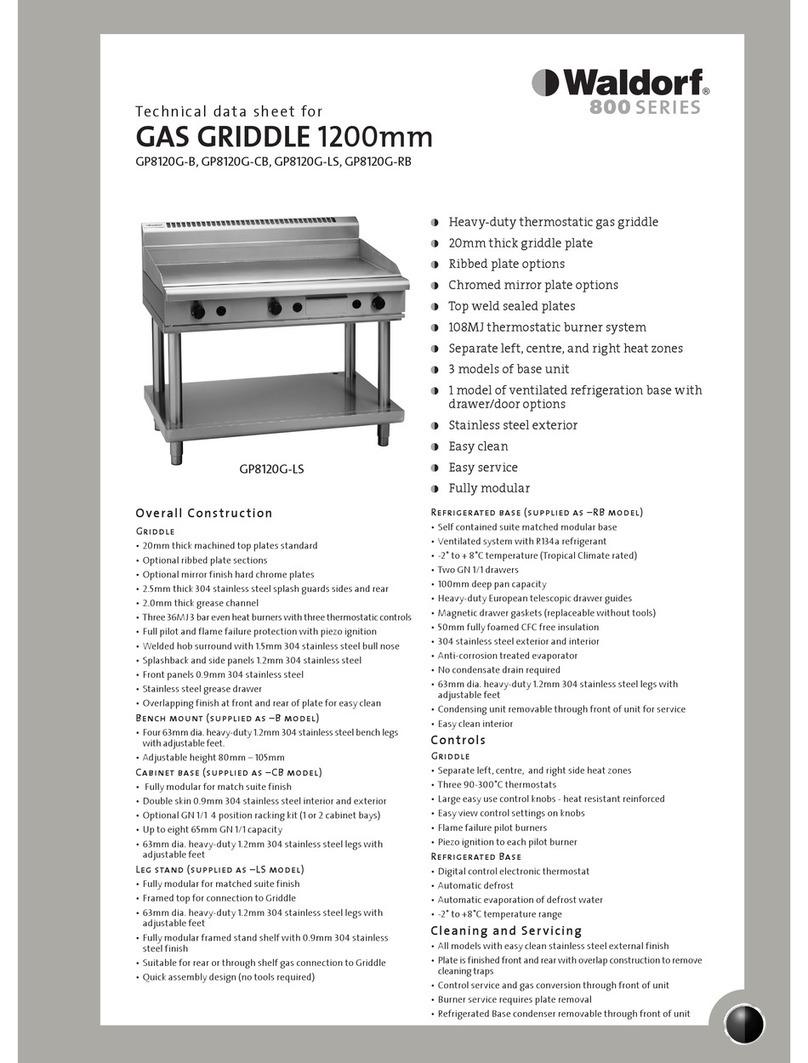
Waldorf
Waldorf GP8120G-CB Technical data sheet
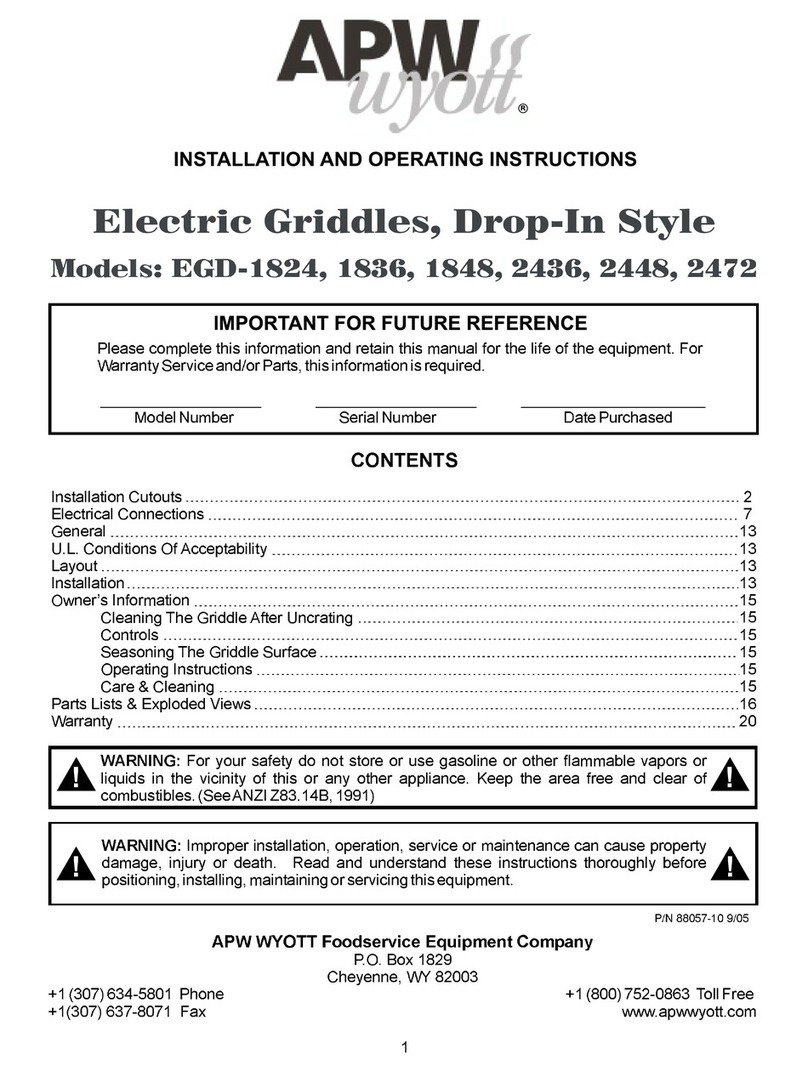
APW Wyott
APW Wyott 1836 Installation and operating instructions

Blizzard
Blizzard BG Series user manual

Keating Of Chicago
Keating Of Chicago MIRACLEAN Operator's training manual
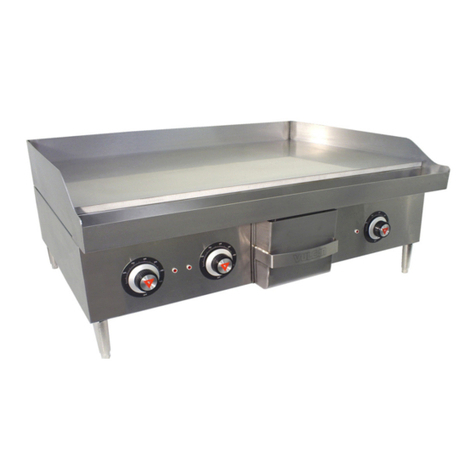
Vulcan-Hart
Vulcan-Hart RRE24D Replacement parts catalog

Amazon
Amazon B09YD91GRR manual
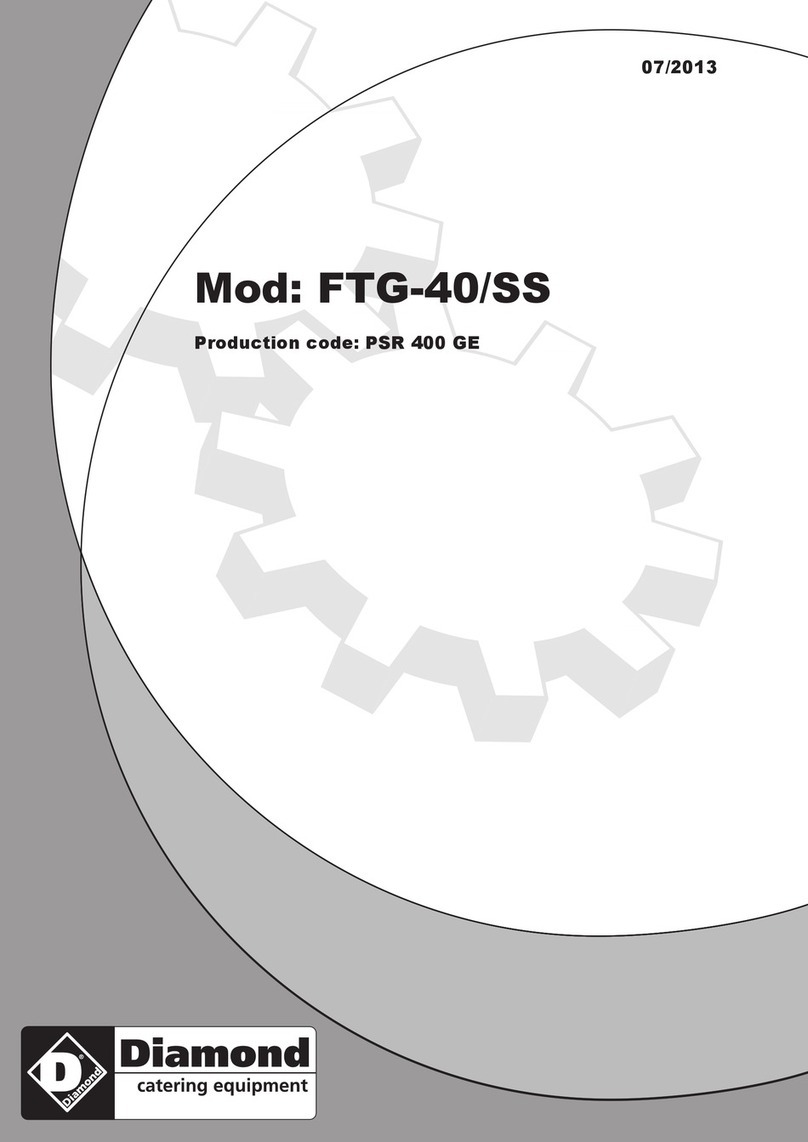
Diamond
Diamond PSR 400 GE Instructions for use and installation
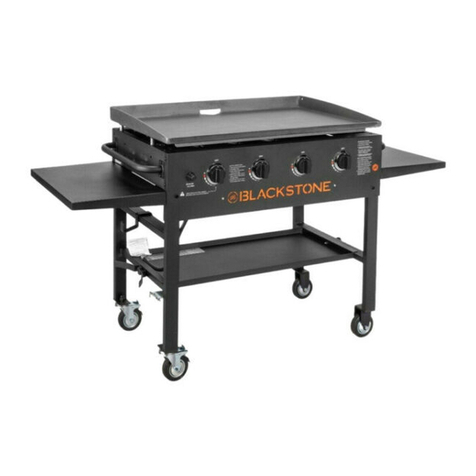
Black Stone
Black Stone 1836 owner's manual
